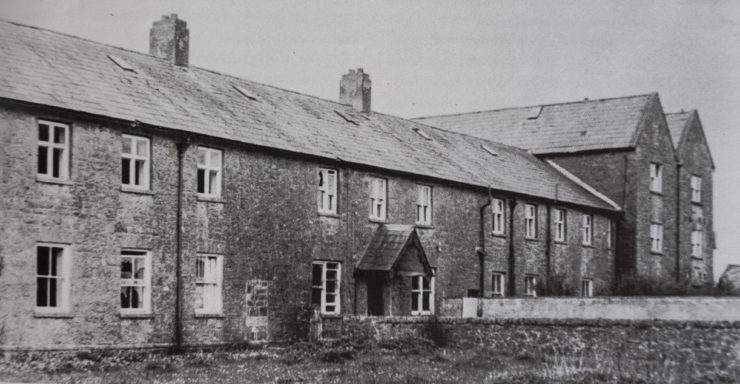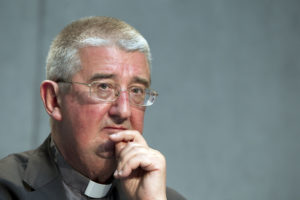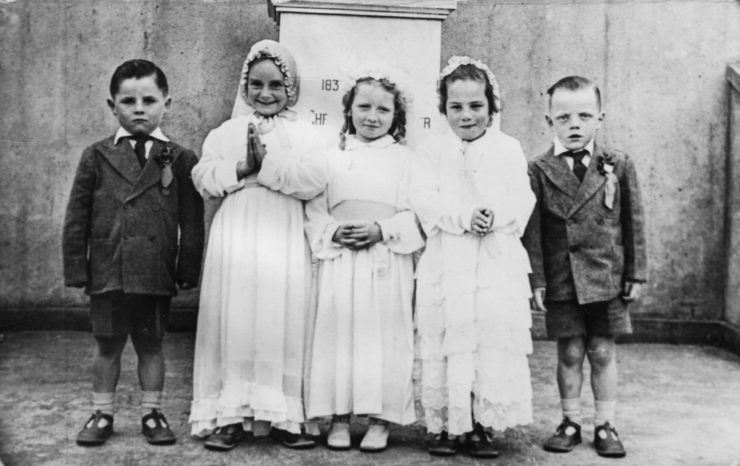If Dan Barry has a beat, it is humanity -- humanity as it reckons with its triumphs and travesties, and, sometimes, its profound secrets.
The veteran reporter and columnist for The New York Times documented pivotal moments in metropolitan lives in his early-2000s-era “About New York” column. For the past decade, Barry has lit out for “obscure and well-known corners of the United States” on behalf of “This Land” -- a column showcasing Americans as they grapple with their unique and complicated landscapes.
Why does Barry begin a story about a long-hidden trove of bones with a girl going to school and playing a trick on her classmate? These opening paragraphs hint at innocence and its loss.
In my favorite “This Land” lede, Barry begins with: “They laid his bones in a bed of Bubble Wrap, with a care beyond that which is normally given to fragile things.” Eventually, Barry explains how the bones were recovered from a mass grave containing remains of Irish railroad workers outside Philadelphia. But at the outset readers don’t know who is carefully packing the bones, or even to whom these bones belonged. Stripped of names, the gesture itself dominates the sentence, allowing us to focus as someone bestows care and dignity to something — to someone.
This impulse to tenderly recognize the deceased is also at the heart of Barry’s story “The Lost Children of Tuam.” Leaving both city and nation behind for this reporting, Barry lays out a disturbing tale, unearthed from Ireland’s sod. Cushioned by the careful narration, we discover another profound collection of neglected bones.
In this lede, Barry deploys a three-word command to the reader: “Behold a child.” His lapel-grabbing “Behold” is fancy language as far as workaday newspapers go. Moreover, “Behold” suggests the synesthesia of sight and touch, which asks us to witness this story in a way that includes embracing, or grasping with a care beyond that which is normally given to fragile things.
His article launches like a novel as we follow a girl, “all of six,” as she traipses the Dublin Road to school. Along the way we learn she’s the daughter of a father who keeps animals and a mother who keeps a secret. Before the two-mile journey is through, the girl will pass “the mother and baby home, with glass shards embedded atop its stony enclosure.”
This schoolgirl is Catherine Corless, the story’s protagonist, and throughout the 7,000-word story, we’ll watch her grow into a mother herself and liberate a heartbreaking secret about home where the nuns “watch over the unmarried mothers and their children,” or, by cultural definition: “sinners and their illegitimate spawn...The fallen.”
But Catherine, as Barry shows us, is herself a fallible character, a girl who, on a whim, fools her classmate, one the home’s offspring. Barry’s opening graphs lead us straight to this scene: “She balls up an empty candy wrapper and presents it to a home baby as if it still contains a sweet, then watches as the little girl’s anticipation melts to sad confusion.”

Why does Barry begin a story about a long-hidden trove of bones with a girl going to school and playing a trick on her classmate? In addition to establishing the time (1950s) and place (a town in County Galway whose name derives from a “word that means ‘burial mound’”) these opening paragraphs hint at innocence and its loss. Also, the reader needs to meet this “fallen” child of Ireland, and she needs to be palpable. Alive.
Barry’s strongest hint as to where we are headed doesn’t come until the 11th spare graf, where he allows: “Deep in the distant future,” Catherine will expose the home’s appalling truths. She will prompt a national reckoning that will leave the people of Ireland asking themselves: Who were we? Who are we?”
I know — huge, right? But settle in, Barry’s got 6,000 more words to go.
As Catherine, the curious girl, matures into mother and grandmother, the story matures from mystery to astounding revelation.
Invoking the passage of time — “some sixty years have passed since Catherine’s primary school days” — Barry cites her call to action: “One day, a few years back, Catherine began to inquire about the old home that had stoked her schoolgirl imagination.” He charts her trajectory: “She set out on an amateur’s historical quest, but whenever she focused on the children who lived there, so many questions arose about the children who died there—the ones who never made it to the classroom, or even past infancy.”
From there Barry takes us un-gently into the darkness. Neither sugarcoating nor slandering, Barry explains the circumstances of the state-financed place where the “disgraced might be redeemed”: “Given the misogyny, morality and economics that informed the public debate at the time — when a pregnancy out of wedlock could threaten a family’s plans for land inheritance, and even confer dishonor upon a local pastor — imagine that naive young woman from the country: impregnated by a man, sometimes a relative, who would assume little of the shame and none of the responsibility.”
A solution: “be shipped to the dreaded Tuam home, run by a religious order with French roots.”
If Dan Barry has a beat, it is humanity — humanity as it reckons with its triumphs and travesties, and, sometimes, its profound secrets.
Then he puts the reader in the young woman’s shoes: “You rose early and went down to the nursery with your infant. Mass at 8, the porridge and tea for breakfast. Breast feeding next, after which you rinsed your child’s diapers before moving on to your daily drudgery. You might polish the dormitory floors with beeswax or clean bedsheets stained with urine.”
How does Barry know? Julia Carter Devany, a 40-year employee of the home, related these details in interviews taped before her death in 1985.
He lets her voice do the work, recounting the administering Sisters and the parent-less children, vulnerable to contagious illnesses, “like chickens in a coop.”
This seven-acre property, which functioned as a “mother baby home” from 1925-1961, comes alive through Julia’s voice, and Barry’s insistence that the reader vicariously experience the hardship and heartbreak of it:
“You preferred to suffer at the mother and baby home bracing for the day when after a year of penitent confinement, you were forced to leave, almost always without your child.”
Barry then returns to Catherine, who has graduated from college, married, had children, and learned, upon her mother’s death, the secret she had long kept. When Catherine discovers that her melancholy mother was an illegitimate child, “into this patch of pain and regret, a seed was planted.”
We learn how Catherine channels her ache for her mother’s experience into an understanding of the day-to-day workings of her local mother and baby home. Eventually her inquisitiveness turns up an anecdote, which Barry delivers in the parish vernacular: “a while back … two lads once found some bones in a concrete pit.”

Despite the boys advertising their discovery, the community deemed them famine bones, so “a priest said a prayer and that was that.”
But Catherine persists with her inquiry. One day she overlays an 1890 town map with one from the modern day and realizes the boys made their discovery at the site of the home’s septic tank.
Barry lets Corless’ questions set the agenda for the rest of the story: “Did this mean, then, that the two lads had stumbled upon the bones of home babies? Buried in an old sewage area?”
Testing her horrifying hypothesis, Catherine buys a batch of home death certificates and tries to locate their graves, but, in almost every case, she can’t.
In a historical society publication, Catherine dares ask: “Is it possible that a large number of those little children were buried in that little plot at the rear of the former home? And if so, why is it not acknowledged as a proper cemetery?” -- a question that Barry frames more boldly: “Had Catholic nuns, working in service of the state, buried the bodies of hundreds of children in the septic system?”
Into the howling silence of no reply, Catherine’s curiosity hardens into a mission. She learns that during the home’s 36-year existence, 796 children died. Barry knows we can do the math, so he lets us grapple with the three-digit number by itself, allowing us to realize it amounts to a small village; that it equates to 22 a year if they died in an orderly fashion.
But the spreadsheet of the deceased comes with its own timeline: In 1925, seven children die. Via Catherine’s research and Barry’s article, these deaths become specific, personal, not simple statistics: Patrick Darrane is the first to die at 5 months old of gastroenteritis; then Mary Blake, 4 months, of anemia; then Matthew Griffin, 3 months old of meningitis, and on they go—“Measles. Influenza…Whooping Cough. Tuberculosis…undernourishment.”
And then another question, plain stated, turns this piece toward the end as Catherine wonders, “They’re not in the main Tuam graveyard where they should have been initially…They’re not in their mother’s hometown graveyards. Where are they?”
Catherine alerts the press, and the answer blares across the front page of a national Irish newspaper. And so Barry’s story encompasses not just the revelation of an appalling secret, but the people and forces that fortified that secrecy.
In the story’s most assertive line, Barry pronounces: “The bitter truth was that the mother and baby homes mirrored the Mother Ireland of the time.” But he closes out the piece not with a nation’s regret, or a religion’s regret, or the Sisters’ regret or even a family’s regret. He picks up his magnifying lens and holds it again over Catherine. The long-ago schoolgirl still has regret about tricking her classmate with a candy wrapper that seemed full but contained nothing. Catherine has not been able to locate her, nor even determine her name. Barry leaves us imagining what it might be like if one day they happened to recognize each other.



